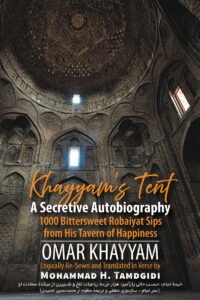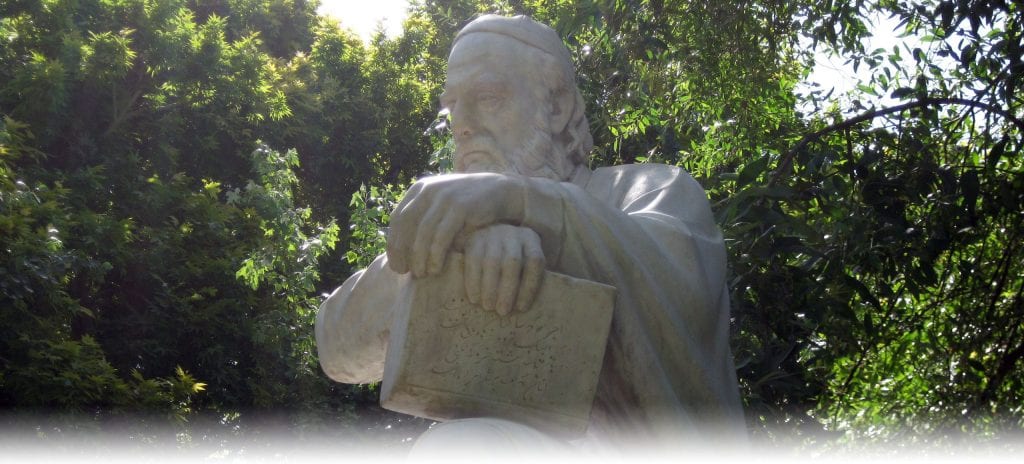
عمر خيام: «گفتمش چيست گفتۀ خيام؟ گفت پيراست حسب حالى چند» — زندگينامۀ خودسرودۀ عمر خيام ٩ قرن پس از درگذشت وى در سالروز صحيح تقويمى تولدش ٢٠ خرداد انتشار يافت.
بوستون، ماساچوست، امريكا، ٢٠ خرداد ١٤٠٤ (June 10, 2025) – دكتر جامعه شناس محمدحسين تمجيدى، مدیر پژوهشكده عمر خيام در آمريكا، در روز ٢٠ خرداد ١٤٠٤ (١٠ ژوئن ٢٠٢٥) كتاب «خيمه خيام: حسب حالى رازآميز: هزار جرعه رباعيات تلخ و شیرین از ميكدۀ سعادت او» را انتشار داد.
براى خواندن اصل اين نشرنامه فارسى به اينجا مراجعه كنيد. براى خواندن اين نشرنامه به انگليسى (English version of this press release) لطفاً به اينجا يا به ادامه اين صفحه مراجعه نماييد؛ براى اصل آن اينجا كليك كنيد.
رباعیات اصيل عمر خیام حماسه ای بوده است همزمان فردى، جهان-تاریخی، و کیهانی در جستجوى سعادت واقعی انسان. او آن را چنان سرود تا همه آن را مدام بخوانند، مانند کتابى براى نيايش يا تسبیحى از مروارید یا یاقوت، زیرا قرار بود نه تنها بازتابنده بلکه مولد جستجوی سعادت بشر باشد. هر یک از بخش هايش مى بايد در بطن معماری حکمت فلسفی، دينى، و علمی آن که در شعرى بغايت شگرف و زیبا هنرمندانه یکپارچه شده اند، درك گردد. خیام درست می گفت. در دنيا هیچ چیز مانند شراب او وجود ندارد.
از آنجا كه قرار بود دفتر (يا نامۀ) عمر او پس از مرگش منتشر شود، معاصرانش از آن اطلاعى نداشتند. اما رباعياتش در اثر بلایای طبیعی و اجتماعی و شیوه هاى نوظهور تنظيم الفبايى و انتخابى اشعار پراکنده شدند و یکپارچگی منطقی خُم آنها در هم شکست. از اينرو برخی رباعیات وى در آثار شاعران دیگر سرگردان و برخی از دیگران نيز به اشتباه به او منسوب شدند. رباعیاتی که در كتاب « خيمۀ خيام» آمده است حين مطالعات يكپارچۀ همۀ آثار خیام در مجموعۀ ١٢-جلدى «راز عمر خیام: پيام شناسى رباعیات در انديشۀ جامعه شناسى ذره-موجى» بطور منطقی بازدوزى و منظوم ترجمه شدند.
 در «خيمۀ خيام»، رباعيات وى، مشتمل بر سرودهاى ترديد، امید، و شادی، در سه بخش بر اساس روش تحقیق سه گامى که خیام خود در رسالۀ «الكون و التكليف» («جهان آفرينش و تكليف نيايش») معرفی کرد، بطور منطقی برای پاسخگویی به سه پرسش تنظیم شدهاند.
در «خيمۀ خيام»، رباعيات وى، مشتمل بر سرودهاى ترديد، امید، و شادی، در سه بخش بر اساس روش تحقیق سه گامى که خیام خود در رسالۀ «الكون و التكليف» («جهان آفرينش و تكليف نيايش») معرفی کرد، بطور منطقی برای پاسخگویی به سه پرسش تنظیم شدهاند.
رباعیات ١-٣٣٨ در بخش اول، سرودهای ترديد، با توضیح دلايل رازآميز بودن حماسۀ او آغاز می شوند و به این سؤال می پردازند که «آیا سعادت وجود دارد؟» سلسله ترتيب آنها از یک استدلال منطقی استقرایی پیروی می کند که از طریق آن خیام از غم نگارى هاى روزمره به كاوش زنجیرۀ عمیق تر علل آنها می پردازد. رباعیات ٣٣٩-٦٨٥ در بخش دوم، سرودهای امید، به سؤال دوم «سعادت چیست؟» مى پردازند. سلسله ترتیب آنها از یک استدلال منطقی قیاسی پیروی می کند که از رباعیات روش شناختی به رباعیات توضیحی و عملی گذار مى كنند. رباعیات ٦٨٦-١٠٠٠ در بخش سوم سرودهای شادی هستند و به سوال سوم “چرا سعادت می تواند وجود داشته باشد؟» مى پردازند. آنها هنوز به صورت قیاسی مرتب شدهاند ولى عملاً نشان میدهند که چگونه میتوان شادی را از طریق خود شراب شعر او ممکن كرد، با اين درک که انسان هرگز نمیتواند با ایجاد غم و اندوه برای دیگران واقعاً سعادتمند شود، زیرا خويشتن انسان و جامعۀ او هميشه همزاد و جهانشمول هستند. آزار دیگری همیشه آزار آن خويشتنى در توست که جلوه گاه آن ديگرى است. از نظر خیام، سعادت میتواند با تلاشهای شادى بخش، خلاق، سازنده و خودنمونه آورانه براى پرورش انسانيت، مانند رباعیاتش، تحقق يابد بشرطى كه از امروزهاى درون و ميان فردى ما آغاز گردند و در جهان گسترش يابند.
رباعیات خیام آن خیمهای است که عمر خيام «خیمهدوز» آن بوده است. تخلّص شاعرانهاش ملهم از طالع تاریخ تولد صحيح او بود، تاريخى كه در پژوهش مجموعۀ «راز عمر خيام» براى اولين بار يافت شد. استعارۀ «خيمه» همچنین زیربنای هندسۀ عددی مثلث هزار رباعى اوست كه متناسبند با مثلثه هاى خیرهکنندۀ طالع تاريخ صحيح تولد او، همانطور که او قاعدۀ زرّين مثلث ابداعى خود (مشروح در رسالۀ «ربع دايره») را در طرح اسرارآمیز گنبد شمالی اصفهان زيركانه پنهان کرد. استعاره ای از رباعيات به منزلۀ سرودهاى سیمرغ نیز در ساختار عمیق رباعيات او نهفته است. رباعیات خیام، ترانههای بازآيى هزارسالۀ سیمرغ اوست که در خيمۀ ميكده اش بهعنوان هزار جرعه از شراب تلخ و شیرین شاعرانهاش ارائه شده اند.
دكتر وینستون ای. لنگلی، استاد و مدير هيئت علمى سابق دانشگاه ماساچوست در بوستون، در ديباچه اى براى آخرین کتاب مجموعۀ ١٢-جلدى «راز عمر خیام» مى گويد: «در واقع، برای اينجانب که در سنین جوانى با رباعيات خیام از منظر ادوارد فیتزجرالد آشنا شدم، مواجهه با مجموعۀ «راز عمر خيام» مانند تجربۀ فضانوردانی بود که برای اولین بار كرۀ زمین را از فضا مشاهده کردند. چنين تجربه اى برايم از قبل حتّى متصوّر نبود. … در آثار خیام، به ویژه در شعر او، دل مشغولى هاى غم نگارانى را مى يابيم که پيشۀ نويسندۀ گیلگمش يا نويسندگانى نظير سوفوکل، شکسپیر و گوته بوده است. با چنان اضطراب، ترديد، و عبث نگرى هايى روبرو می شويم كه طعم داستایفسکی، کی یرکگور، کامو و کوبو آبه را به ما مى چشانند. به تيزبينى هاى بس دقيقى بر مى خوريم كه حس مى كنيم در محضر بودا، پوشکین و نبوغ عملی داوینچی و بیکن هستيم. و كسى که اهل دل و مسائل ایمان و عقل و عشق و سعادت است، با سخنانى از نظاير ارسطو، سنت آگوستین و آکویناس گرفته تا زارا ژاکوب، جفرسون و بونهوفر مواجه مى شود. برای مثال، سعادت نه فقط حالتى از بهزيستى، بلکه فرآیندى از آزاده زيستى مداوم نيز هست. … اگرچه زندگی خیام خود داستان شور و شوق جدّى روشنفکرى است كه به آرمانهای فلسفه، علم و شعر (و شیوه هايى از زندگى كه انزواگزينى و شهرت يا خصوصی و عمومی را با هم مى آميزند) عميقاً وفادار مى باشد، وى جايى را نيز به آنچه بخشی از هویت اوست اختصاص مى دهد، بخشى که نمی توان آنرا ناعادلانه در پژوهش، تاریخ و فرهنگ بشری نادیده گرفت. و آن نقش طنز است — آنچه که با شوخ طبعى معایب عقل، علم، فلسفه (از جمله الهیات)، سیاست، تاریخ، عُرف (هرچند مقدس) را حتی هنگام مواجهه با ناامیدی های عمیق یا فجایع زندگی نقد می کند. همانطور که آریستوفان، سروانتس، ویکو، اراسموس، سانتایانا و چخوف میدانستند، استقبال از کمدی بخشی از شناخت، خرد، و تضمین شکوفایی انسان است. شاید بتوان گفت خیام نخستین انسان گراى واقعی بوده است. هر آنچه انسانى است از طریق او به وضوح جلوه گر مى شود.»
دكتر جعفر آقایانی چاوشى، استاد تاريخ فلسفه و شناخت شناسى علم در دانشگاه صنعتی شریف و از پيشگامان ايران در مطالعات علمى عمر خیام مجموعۀ ١٢-جلدى «راز عمر خیام» را «شاهکاری در مطالعات عمر خیام» ارزيابى كرده است.
———————————————————————
دكتر محمدحسين (بهروز) تمجيدى بنیانگذار «اكسير: مرکز عمر خیام براى پژوهش يكپارچه در آرمانشهر، عرفان و علم» (عرفانشهرسازى) (www.okcir.com) و دانشيار سابق نظريه پردازى جامعه شناسى دردانشگاه ماساچوست در بوستون است.
Mohammad Tamdgidi
OKCIR: Omar Khayyam Center for Integrative Research
[email protected]
OKCIR’s EIN Newswire Press Release Links
PREVIEW
The English translation of the above Press Release, as previously released on May 27, 2025.
The book reveals the unitary architecture of his Robaiyat’s philosophical, religious, and scientific wisdom as an epic poem in search of true human happiness.
GREATER BOSTON, MASSACHUSETTS, UNITED STATES, May 27, 2025 — Sociologist Mohammad H. Tamdgidi, Ph.D., research director at OKCIR (Omar Khayyam Center for Integrative Research), will release on June 10, 2025, on Omar Khayyam’s true birthday, the new book Khayyam’s Tent: A Secretive Autobiography: 1000 Bittersweet Robaiyat Sips from His Tavern of Happiness. It offers the original Robaiyat of Omar Khayyam (AD 1021-1123) as a tent of 1000 logically sewn quatrains serving the poetic Wine of his secretive autobiography.
The original Robaiyat of Omar Khayyam (AD 1021-1123) as shared in the forthcoming OKCIR book is an epic, at once a personal, world-historical, and cosmic search for true human happiness. Khayyam composed it to be highly readable so that it can be read by all, continually, and today, before it is too late, like a prayer book or a rosary of pearls or ruby stones, since it was meant to be not only reflective but also generative of search for happiness. If you begin reading it, you must do so at least once to its end, so that in later readings any of its parts can be recalled amid the unitary architecture of its philosophical, religious, and scientific wisdom rendered as an astounding and most beautiful work of art. Khayyam was right; there is nothing on Earth like his Wine.
His poetic “book of life” was intended to be released posthumously, so its existence was not known to his contemporaries. Following his death, it was released but became scattered and its logical unity was shattered by natural and social disasters and scribal poetry alphabetizing styles, some quatrains wandering into other poets’ works and others becoming misattributed to him. The Robaiyat as shared in the OKCIR book were logically re-sewn and newly translated in verse by the sociologist Mohammad H. Tamdgidi during his integrative study of all of Khayyam’s works as reported in his unprecedented 12-book series Omar Khayyam’s Secret: Hermeneutics of the Robaiyat in Quantum Sociological Imagination, whose last book (12th) will also be published on June 10, 2025, simultaneously.
Following a summary of his series’ findings, Tamdgidi presents in the book nothing else but Khayyam’s Robaiyat, including the Persian originals and his verse translations (his study of them having been shared in his series, especially its Books 8-12). The quatrains, comprising songs of doubt, hope, and joy, are logically organized to address three questions, based on the 3-phased method of inquiry Khayyam himself introduced in his other writings.
Quatrains 1-338 of Part 1, Songs of Doubt, open by explaining his epic’s secretiveness and address the question “Does Happiness Exist?” Their order follows a logically inductive reasoning through which Khayyam delves from surface portraits of unhappiness to their deeper chain of causes. Quatrains 339-685 of Part 2, Songs of Hope, address the second question “What Is Happiness?” Their order follows a logically deductive reasoning through which he moves from methodological to explanatory and practical quatrains. Quatrains 686-1000 of Part 3, Songs of Joy, address the third question “Why Can Happiness Exist?” Still deductively ordered, they show how happiness can be made possible through his poetry’s Wine itself, realizing that one can never become truly happy by bringing sadness to others since human self and society are always twin-born and universal. Hurting another is always a hurting of that self in you that represents that other. For Khayyam, happiness can be possible by way of joyful, creative, and constructive humanizing efforts by own example, like his Robaiyat, which must also start from our inner and interpersonal todays and spread globally.
Khayyam’s Robaiyat represented the tent of which he was a “tentmaker,” his poetic pen name having been inspired by his true birth date horoscope chart as discovered by Tamdgidi and reported in his series for the first time. The metaphor also underlies the numerical geometry of its triangular unity, proportional to the dazzling Grand Tent (Triplicity) features of his birth chart, the same way he embedded his own triangular golden rule in the mysterious design of Isfahan’s North Dome. A metaphor of the Robaiyat as Simorgh (or Phoenix) songs is also hidden in its deep structure. Khayyam’s Robaiyat are his Simorgh’s millennial rebirth songs served in his tented tavern as 1000 sips of his bittersweet poetic Wine of happiness.
Winston E. Langley, Professor Emeritus and former Provost of UMass Boston, wrote in his Foreword to the last book of the series: “Tamdgidi’s offering in his Omar Khayyam’s Secret series of a translated tri-partite and then, integrated, version of this poem (this epic) is of utmost importance. … In Khayyam’s work, especially his poetry, one finds the pathos of the tragedian, with the author of Gilgamesh, Sophocles, Shakespeare, and Goethe calling; one comes face to face with anxiety, doubt, and the absurd, and tastes Dostoevsky, Kierkegaard, Camus, and Kobo Abe; one confronts subtleties of the most refined kind and meets Buddha, Pushkin, and the practical genius of Da Vinci and Bacon; and one, confronted with the heart and matters of faith and reason, love and happiness, finds voices from Aristotle, St. Augustine, and Aquinas, to Zara Jacob, Jefferson, and Bonhoeffer. Happiness, for example, is not only a state of well-being, but a process of continuing liberation. … While Khayyam’s life is a major story of fierce intellectual passion and a like devotion to ideals of philosophy, science, and poetry (and modes of living that combined those of the solitary and the celebrated, the private and the public), there is an area that is also part of his identity that cannot be overlooked without an injustice to scholarship, history, and human culture. It is the role of satire—that which humorously criticizes defects of reason, science, philosophy (including theology), politics, history, custom (however sacred), even in face of deep disappointments or lived catastrophes. Welcoming the comedy, as Aristophanes, Cervantes, Vico, Erasmus, Santayana, and Chekhov knew, is part of coming to know, of wisdom, of ensuring human flourishing. One may say that Khayyam could be regarded as the first true humanist. All that is human find unhidden expressions through him.”
Jafar Aghayani Chavoshi, Professor of Philosophy of Science at Sharif University of Technology in Tehran, Iran, and a pioneer in Iran’s scientific Omar Khayyam studies, has regarded the Omar Khayyam’s Secret series as “… a masterpiece in Omar Khayyam studies.”
Mohammad H. Tamdgidi, Ph.D., is the founding director of OKCIR: Omar Khayyam Center for Integrative Research in Utopia, Mysticism, and Science (Utopystics) (www.okcir.com, est. 2002). He is a former associate professor of sociology specializing in social theory at UMass Boston.
Mohammad H. Tamdgidi
OKCIR: Omar Khayyam Center for Integrative Research
[email protected]
OKCIR’s EIN Newswire Press Release

